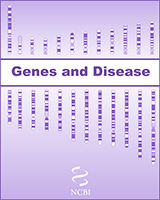NCBI Bookshelf. A service of the National Library of Medicine, National Institutes of Health.
National Center for Biotechnology Information (US). Genes and Disease [Internet]. Bethesda (MD): National Center for Biotechnology Information (US); 1998-.
The human genome is often referred to as a "blueprint" and contains all of the information and instructions necessary for defining a human being. The term genome refers collectively to the DNA and associated protein molecules contained in an organism or a cell. The human genome consists of 23 pairs of chromosomes — threadlike packages of genes and other DNA — with each parent contributing one chromosome to each pair.
A gene is a specific sequence of DNA and is actually the functional unit of inheritance. Most genes contain the information needed to make a protein, or molecules that carry out all of a cell's vital activities. Therefore, slight variations in genes lead to slight changes in a protein. Although some human diseases are explained by alterations in a single gene or of a single chromosome, most are complex and may involve multiple genes and protein pathways.
A myriad of genes, as well as environmental factors, are believed to control the complex and integrated processes necessary for fetal development. When one or more of these processes goes awry, it can result in the birth of an individual with a genetic alteration. Scientific studies, often those that use other organisms as a model, will provide information about biological and regulatory processes involved in human development and will identify critical pathways in which genetic changes result in disease. This information will come not only from human studies, but also from other model organisms — such as mouse or yeast — that can provide insights into how key genes operate in complex systems.
- The number of babies that die in the first 28 days of life (neonates) and during the first year of life (infants) has fallen dramatically over the last 50 years.
- Neonatal Diseases - Genes and DiseaseNeonatal Diseases - Genes and Disease
Your browsing activity is empty.
Activity recording is turned off.
See more...
